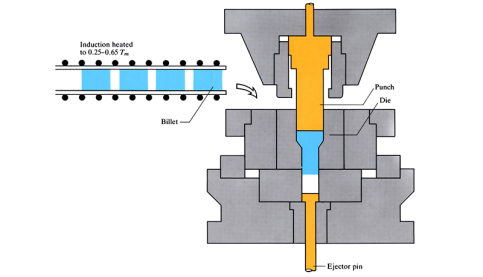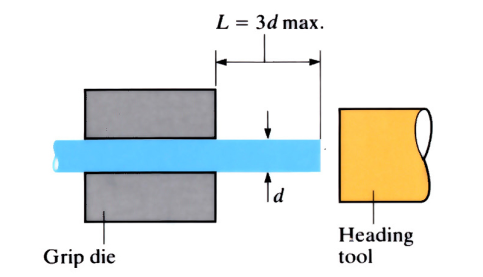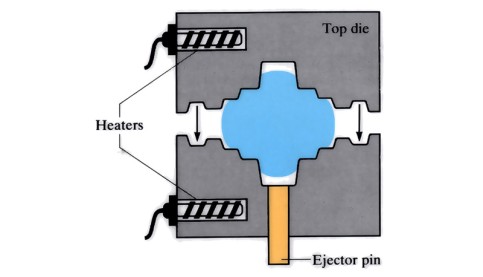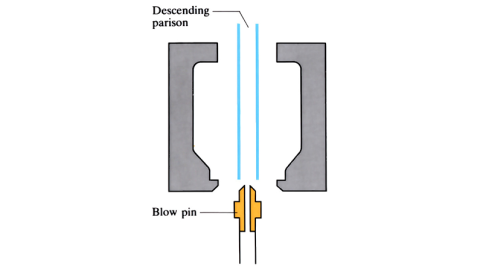 article icon
article icon
Science, Maths & Technology
Warm forging
The workpiece billet is heated to temperatures between 0.25 and 0.6 Tm. A close fitting punch is used to exert pressure on the malleable metal billet held in a heated, closed die until forged to the required shape.
 article icon
article icon
Science, Maths & Technology
Cold forging
A forging process carried out at temperatures below 0.25Tm. A closely fitting punch is used to exert pressure on malleable metal held in the die.
 article icon
article icon
Science, Maths & Technology
Axiforge process
Axiforge process can be carried out on dies, positioned on vertical or horizontal axes, within a press. Sideways ram movements apply pressure to the outside of a split die, so that the two parts close around a heated billet, forming it into the required external shape. This is followed by pressure from one or two piercing punch(es), which pierce...
 article icon
article icon
Science, Maths & Technology
Orbital forging
Workpiece material is forged between two dies. The bottom die moves upwards whilst the top die, tilted to a preset angle, rotates (orbits) around the central axis, progressively forming the malleable material into the required shape.
 article icon
article icon
Science, Maths & Technology
Rotary Forging, General Forging Machine (GFM) and Swaging
A circular housing contains a rotating shaft (rotor) holding free moving anvils. At the end of each anvil is a die. The dies surround a centrally placed workpiece. Revolving around the rotor is a cage holding loosely rotating rollers. As the cage rotates, the rollers impact on the anvils, which effectively hammer the stationary workpiece into ...
 article icon
article icon
Science, Maths & Technology
Isothermal precision forging
The workpiece is formed to shape at a slow rate and at a temperature almost equal to that of the heated die. The long forging time, alongside forces exerted by the die, help to form an almost ‘ready to use’ component needing minimal supplementary machining.
 article icon
article icon
Science, Maths & Technology
Upset forging
A heading tool or ram is positioned perpendicular to the cross sectioned end face of a rod or bar gripped in a die. On application of pressure, the length of the rod is reduced and the diameter is increased (upset). This manufacturing process is used extensively in the production of fasteners, to form bolt heads, screw heads etc.
 article icon
article icon
Science, Maths & Technology
Hot extrusion
A ram forces a heated billet to flow through a shaped hole in a die. Can be forward, backward or hydrostatically extruded.
 article icon
article icon
Science, Maths & Technology
Hot rolling
Plates, flat sheets or billets of metal, heated to above their material recrystallisation temperature, are passed between two rollers. The result is a thinner cross section of material with a finer grain structure.
 article icon
article icon
Science, Maths & Technology
Hot forging (closed die)
Two halves of a heated die move towards each other, incorporating the metal material to be forged and filling the die cavities. The two die halves are clamped together, and the metal is left to solidify. After extraction from the dies, flash is removed from the forging. To eliminate flash formation, a single part heated die can be used instead, ...
 article icon
article icon
Science, Maths & Technology
Hot forging (open die)
Open die forging is a hot forming process in which the metal is shaped by hammering or pressing between two flat or simple contoured dies.
 article icon
article icon
Science, Maths & Technology
Blow moulding
A process for forming plastic, thin walled, hollow containers such as bottles. Raw thermoplastic in the form of pellets, or granules, is melted and extruded to make parison tubes. The parisons are clamped centrally between two halves of a closed mould. Pressurised air is used to inflate the parisons, until they conform to the shape of the mould ...